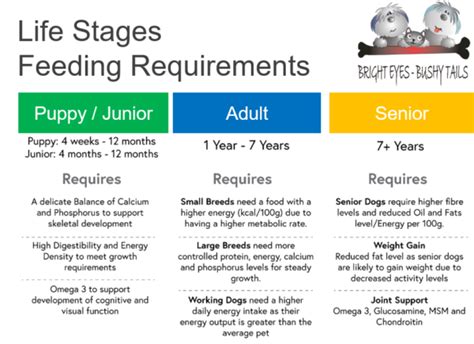Introduction
Pets, our furry companions, enrich our lives with unconditional love and loyalty. As responsible pet owners, providing them with optimal nutrition throughout their different life stages is crucial for their well-being and longevity. Pet food manufacturers have created specialized diets tailored to each stage of a pet’s life, addressing their specific nutritional needs and health concerns. In this comprehensive guide, we will delve into the complexities of pet food for different life stages, empowering you with the knowledge to make informed choices for your beloved companion.

Nutritional Requirements Across Life Stages
Kittens and Puppies
Kittens and puppies are rapidly growing and developing, with high energy requirements. Their food should be calorie-dense and rich in protein, fat, and carbohydrates to support their rapid growth and development. Specialized diets for kittens and puppies often contain specific nutrients, such as DHA (docosahexaenoic acid), which is essential for brain and eye development.
Adult Pets
Adult pets have reached their mature size and have different nutritional needs than growing kittens and puppies. Their food should provide a balanced diet that maintains their weight and energy levels. Adult pet food typically contains moderate levels of protein, fat, and carbohydrates, with a focus on maintaining optimal body condition.
Senior Pets
As pets enter their senior years, their metabolism slows down, and they may have reduced activity levels. Their food should be lower in calories and fat to prevent weight gain, and higher in fiber to promote digestive health. Senior pet food often contains additional supplements, such as glucosamine and chondroitin, to support joint health.
Choosing the Right Food
When selecting pet food for different life stages, consider the following factors:
- Age and weight: The food should be appropriate for the pet’s age and weight to meet their specific nutritional needs.
- Activity level: Active pets require more calorie-dense food than sedentary pets.
- Health conditions: Pets with health conditions, such as allergies or digestive issues, may need specialized diets.
- Quality ingredients: Look for pet food made with high-quality, human-grade ingredients to ensure optimal nutrition.
Specific Dietary Considerations
In addition to the general nutritional requirements, certain pets may have specific dietary considerations:
- Allergies: Pets with food allergies may need hypoallergenic diets that exclude common allergens, such as chicken, beef, or grains.
- Digestive issues: Pets with digestive sensitivities may benefit from diets that are easy to digest, such as those made with limited ingredients or novel proteins.
- Dental health: Dry pet food can help maintain dental health by reducing plaque and tartar buildup.
Tables for Quick Reference
| Life Stage | Protein (%) | Fat (%) | Carbohydrates (%) |
|---|---|---|---|
| Kittens | 30-40 | 15-25 | 20-30 |
| Puppies | 25-35 | 10-15 | 30-40 |
| Adult Pets | 18-25 | 5-10 | 40-50 |
| Senior Pets | 15-20 | 5-8 | 45-55 |
| Specific Dietary Considerations | Key Ingredients to Look For |
|---|---|
| Allergies | Limited ingredients, hypoallergenic proteins |
| Digestive issues | Easily digestible ingredients, novel proteins |
| Dental health | Dry food, dental chews |
Comparison of Case Studies
Case 1: Allergies
- Pet: 5-year-old Labrador retriever with severe allergies to chicken and beef
- Solution: Hypoallergenic diet made with lamb and rice
- Result: Significant reduction in allergy symptoms, improved skin and coat health
Case 2: Digestive Issues
- Pet: 2-year-old German shepherd with chronic diarrhea
- Solution: Low-fat diet made with novel protein (duck) and prebiotics
- Result: Improvement in digestive health, reduced diarrhea frequency
Frequently Asked Questions (FAQs)
-
When should I transition my pet to a different life stage food?
– Kittens and puppies: At 6-8 months of age
– Adult pets: At 1-2 years of age
– Senior pets: At 7-8 years of age -
How often should I feed my pet?
– Kittens and puppies: 3-4 meals per day
– Adult pets: 2-3 meals per day
– Senior pets: 1-2 meals per day -
Can I mix different types of pet food?
– Yes, but it’s important to consult with a veterinarian to ensure that the combination provides a balanced diet. -
What if my pet has a specific health condition?
– Special diets are available for pets with specific health conditions, such as allergies, digestive issues, and kidney disease. -
How do I know if my pet is eating the right amount of food?
– Monitor your pet’s weight and body condition score. They should have a healthy weight and a waist that is visible when viewed from above. -
Is it important to read pet food labels?
– Yes, pet food labels provide valuable information about the ingredients, nutritional content, and feeding instructions.
Conclusion
Providing your pet with the right food for each life stage is essential for their health and well-being. By understanding the specific nutritional needs and health concerns of different life stages, you can make informed choices about their diet. Remember to consult with your veterinarian regularly to ensure that your pet is getting the optimal nutrition they need to live a long and healthy life.





















